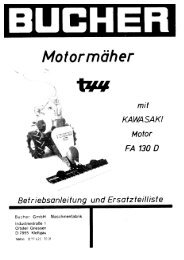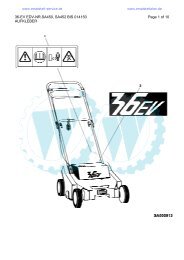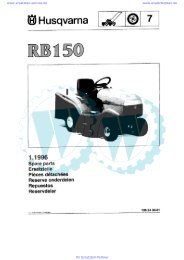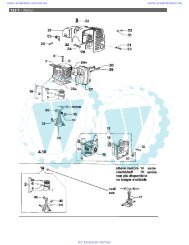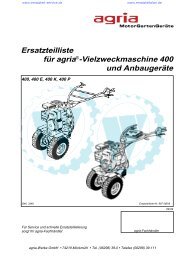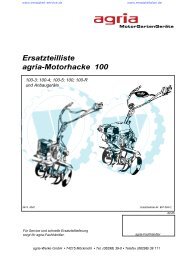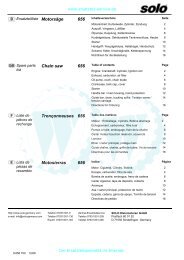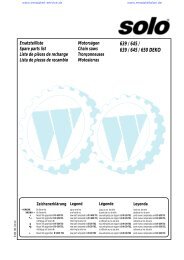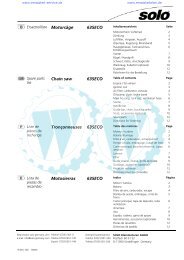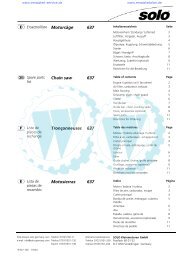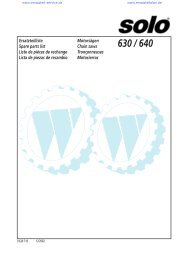Solo Gartengeraete - Ersatzteilplan
Solo Gartengeraete - Ersatzteilplan
Solo Gartengeraete - Ersatzteilplan
You also want an ePaper? Increase the reach of your titles
YUMPU automatically turns print PDFs into web optimized ePapers that Google loves.
www.ersatzteil-service.de www.ersatzteilplan.de<br />
SHUTTING OFF ENGINE<br />
Shut the engine off with the ignition switch (A) to „Off“ (position<br />
marked „Stop“ - „O“) (fig.35).<br />
The engine must definitely be shut off during:<br />
• Service, work breaks, refueling, transporting.<br />
• Sharpening chain.<br />
• When saw is not in use<br />
- Immediately shut off engine if a noticeable change in handling<br />
characteristics occur.<br />
- Remember never place hot chain saw on dry grass or other<br />
flammable objects. The muffler emits tremendous heat capable<br />
of ignition (danger of fire).<br />
TRANSPORTING (FIG. 36)<br />
- When transporting saw or changing work<br />
locations, shut off engine and/or put chain<br />
brake on to avoid accidental chain rotation.<br />
- Never carry or transport the chain saw with rotating saw chain.<br />
- In case chain saw is to be transported over a long<br />
distance, definitely slide cover over saw chain.<br />
- Carry chain saw only at front handlebar. The guide bar faces to<br />
the rear and muffler away from body. Avoid contact with the<br />
muffler to prevent serious burns.<br />
- When transporting in a vehicle make sure the chain<br />
saw is properly secured to avoid spilling fuel and bar oil.<br />
- For extended storage or shipment of the chain saw, run engine<br />
until tank is dry or empty tank of fuel and bar oil.<br />
CARE AND MAITENANCE OF BAR AND CHAIN<br />
SAW CHAIN<br />
As with any cutting tool, the saw chain too is subject to normal<br />
wear. A chain saw performs best with a correctly sharpened saw<br />
chain. Each chain design, cutting performance, and configuration<br />
is adapted to a specific chain saw model (fig.37).<br />
The most important distinguishing characteristics of a saw chain<br />
are:<br />
1. Cutter shape (A)<br />
2. Pitch (B) as well as<br />
3. Drive link gauge (C)<br />
1. The cutter design is distinguished as:<br />
a) Chisel cutter (squared chisel, professional type chain saws)<br />
(fig.37).<br />
b) Chipper cutter (rounded chisel, consumer and hobby chain<br />
saws) (fig.37b).<br />
2. The chain pitch determines the measurement of the chain. It is<br />
equal to the distance between 3 rivets divided by two. The pitch is<br />
stated in inches, the internationally accepted measurement<br />
standard. (fig.37b)<br />
Pitch Deriveline gauge<br />
inches = (mm) mm = (inches)<br />
3/8" 90 SG (9,32 mm) 1,1 mm (.042")<br />
3/8" S (9,32 mm) 1,3 mm (.050")<br />
.325" (8,25 mm) 1,5 mm (.058")<br />
3/8" (9,32 mm) 1,5 mm (.058")<br />
.404" (10,26 mm) 1,6 mm (0.63")<br />
3) The drive link „gauge“ or chain gauge is the thickness of the<br />
bottom section of the drive link which fits into chain saw bar<br />
groove (fig.37c).<br />
CAUTION! Use only SOLO approved and original<br />
SOLO replacement saw chains and guide bar.<br />
CHAIN TENSION<br />
The correct saw chain tension is very critical to the long service<br />
life of a saw chain. Check chain tension frequently after engine<br />
has been shut off and bar and chain have cooled off.<br />
Follow all instructions carefully on saw chain sharpening.<br />
Incorrectly sharpended chains lead to engine overload and bar<br />
wear and reduces the service life of bar and chain. Additionally,<br />
it causes increased risk of kick-back, which may also result from<br />
enlarged depth gauges.<br />
SHARPENING OF<br />
SAW CHAIN<br />
(Fig. 38/29/40)<br />
WARNING! You must shut off engine before<br />
performing any maintenance on the saw chain,<br />
disconnect spark plug cap (see section on spark plug<br />
replacement) and wear protective gloves!<br />
- For sharpening, use a special chain file with the correct file<br />
diameter. (see filing chart). Standard round files are not suitable.<br />
- File forward only (arrow), lift file up on backstroke (fig.38).<br />
- File the shortest cutter first. The length of this cutter is the<br />
guide for all other chain cutters. (fig.38). All cutters must be equal<br />
in length.<br />
- A file holder simplifies guiding the file since it has markings for<br />
correct file angle (align markings parallel to the saw chain) and<br />
limits the depth (4/5 of file diameter) (fig.39).<br />
General Instructions for Filing Cutters<br />
1. Support file holder on cutter top plate.<br />
2. File cutters on one side of the chain from inside out, then file<br />
the other side.<br />
3. Keep the marker line on the file holder parallel to the center<br />
of the chain.<br />
4. File enough to remove any damage to cutting edges (side plate<br />
and top plate).<br />
FOR YOUR SAFETY! When advancing the chain by<br />
hand while filing cutters, always pull chain forward<br />
toward bar tip. This avoids injury to your hand should<br />
you slip.<br />
FILING TOOL AND SPECIFICATION CHART<br />
Chain<br />
pitch<br />
File diam. File Depth gauge<br />
mm inches Angel setting mm/inch<br />
3/8 90 SG 4,5 .177 30° 0,50mm 0.20"<br />
3/8 S 4,0 5/32 30° 0,65mm .025"<br />
.325 4,5 .177 30° 0,75mm .030"<br />
.325(21BP) 4,8 3/16 30° 0,65mm .025"<br />
3/8 5,5 7/32 30° 0,65mm .025"<br />
.404 5,5 7/32 0,75mm .030"<br />
ADJUSTING THE DEPTH GAUGE SETTING (Fig.40)<br />
Filing direction<br />
Level 10° upwards<br />
The distance between depth gauge and cutter (round nose) and<br />
cutting edge determines the size of the wood chip.<br />
17<br />
X<br />
X<br />
X<br />
X<br />
X<br />
X



